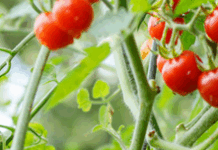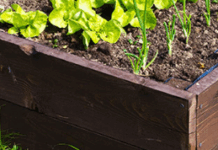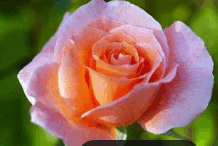https://hnr.k-state.edu/extension/info-center/newsletters/index.html
Blog Post: http://www.ksuhortnewsletter.org
Video of the Week: Common Tomato Problems, Part 2
https://kansashealthyyards.org/all-videos/video/common-tomato-problems-part-2
REMINDERS
• Check mower blade for sharpness and sharpen if necessary.
• Fertilize annual flowers about every 3to 4 weeks to maintain bloom.
• Check for bagworms even if they were sprayed at the middle of June to see if a respray is needed.
ANNOUNCEMENTS
Kansas Turf & Ornamentals Field Day
The Kansas Turf & Ornamentals Field Day will be held Thursday, August 3 at the K-State Research Center in Olathe (35230 W. 135th).
The field day program is designed for all segments of the turf & ornamentals industry – lawn care, athletic fields, golf courses, landscape, nursery, and grounds maintenance. Included on the program are research presentations, problem diagnosis, commercial exhibitors, and equipment displays. There will be time to see current research, talk to the experts and get answers to your questions.
One hour of pesticide recertification credit in both 3A and 3B are available, as well as GCSAA education points.
For a copy of the program and to register to attend, go to https://www.kansasturfgrassfoundation.com/
VEGETABLES
Harvesting Garlic
Garlic bulbs are usually ready for harvest from late June through early July. When about half of the leaves have turned yellow, the bulbs can be gently dug up. Waiting too long to harvest can result in the skins splitting and exposing the cloves to the soil. Harvesting too soon will result in immature cloves.
It is best to use a broad-fork to loosen the soil and unearth the bulbs due to the strong root system of garlic. Throughout the harvesting process be careful not to bruise the bulbs. Leave the roots and leaves intact for the curing process. Tie the bulbs by their leaves in groups of ten and hang in a warm, dry and well-ventilated area for several weeks. Once the curing is done cut the stems and roots to about one-half inch from the bulb. If the bulbs are dirty, remove the outer layer of skin using caution to not expose the cloves. Store the cured bulbs in a cool, dry location. The shelf-life for garlic bulbs is dependent on variety as well as storage conditions but plan on using the garlic within the year. (Cynthia Domenghini)
Vegetables Produce Flowers But Not Fruit
There are several reasons why healthy vegetable crops produce flowers and no fruit. Most squash, cucumbers and melons have separate male and female flowers on each plant. Usually, male flowers appear first in the season. Female flowers have a swollen area beneath the petals while male flowers have a narrow base. Check your plants to see if both flower types are present.
If male and female flowers are present, observe the area for pollinators. If few to no pollinators are present vegetables with separate male and female flowers may not produce fruit. Using a paintbrush, you can pollinate the flowers by transferring pollen from a male flower to the stigma of the female flower. Mark that flower and notice if it is the only one that sets fruit. If this is the case the problem is likely a lack of pollinators.
Pollinator activity can be inhibited by the weather. They are less active on cold or rainy days. Use of insecticides can also harm pollinators. If using herbicides, apply them in the evening when the flowers have closed for the day.
High temperatures can cause some vegetables to drop their blossoms prematurely. Tomatoes will stop producing fruit in temperatures above 95 degrees F. Production will resume once temperatures decrease. Ensure plants are receiving adequate water during this time.
Applying nitrogen promotes vegetative growth. However, excessive amounts can inhibit flower and fruit production. Follow fertilizer recommendations to avoid this. (Cynthia Domenghini)
TURFGRASS
Brown Patch on Tall Fescue
We have been receiving numerous reports of brown patch showing up on tall fescue. This disease is favored by warm night temperatures and extended periods of leaf wetness. If you go outside in the morning and the lawn is covered with dew and the temperature is in the high 60s or higher, it means that conditions are getting right for brown patch. The fungus is primarily a leaf pathogen and does not attack the roots. During severe outbreaks, the fungus may invade the lower leaf sheaths and crown and kill plants. But in most cases, the turfgrass can recover from brown patch. This recovery may take two to three weeks, depending on weather.
There is no way to eliminate brown patch from a lawn. It will persist indefinitely in the soil. Therefore, the disease is not carried from one lawn to another. In almost all cases, the limiting factor for brown patch development is the weather, not the amount of fungal inoculum. Although you can’t eliminate the fungus, cultural practices – especially irrigation – can help control it. Don’t water in the evening; instead, water early in the morning. This will help decrease the number of hours the leaf tissue remains wet and susceptible to infection. The frequency of irrigation is not as important as the time of day you do it. Don’t overfertilize and certainly don’t fertilize when brown patch is active. Also, don’t allow your seeding or overseeding rates to become too high.
Fungicides can be effective in preventing brown patch, but the two most commonly used products (Heritage and ProStar) are expensive and not available in small quantities to the general public. Homeowners do have access to some effective products including triadimefon (Green Light Fung-Away), propiconazole (BioAdvanced Fungus Control for Lawns, Fertilome Liquid Systemic Fungicide II) and myclobutanil (Immunox, F-Stop Lawn & Garden). Of the three, triadimefon may be the fungicide of choice because it protects the turf longer (3 to 5 weeks rather than 2 weeks). But my suggestion is not to use fungicides unless you want to maintain a blemish-free yard and are willing to pay for it. In those cases, you would need to be on a preventative spray program, which is very expensive, rather than waiting for symptoms and applying as a curative. These products do not cure an infection already present but are only effective as a preventative. Applications should begin in mid-June and continue through August. Often tall fescue lawns will recover from brown patch but infections this year seem more severe than usual and may require overseeding this fall. (Ward Upham)
Bermudagrass Control
Bermudagrass can make a nice lawn if you don’t mind its invasiveness and short growing season. But many people dislike both these characteristics. Warm-season grasses, such as bermudagrass, zoysiagrass and buffalograss, green up later than cool-season grasses such as tall fescue and Kentucky bluegrass. They also go dormant earlier in the fall, which can make a lawn unattractive.
Bermuda that invades a cool-season lawn will be brown during much of the spring and fall while the tall fescue portion of the lawn is green. Bermuda is much more drought and heat resistant than cool-season grasses, so it will take over a cool-season lawn during the summer months if it is in full sun.
So, how do you control bermudagrass that has invaded a cool-season lawn? Research conducted in 1996 showed that glyphosate (Round-up, Kleen-up, Killzall, Kleeraway) is the best herbicide for the job. Glyphosate is a nonselective herbicide and will kill everything— including tall fescue or Kentucky bluegrass. Therefore, you will need to reseed treated areas. In our study, we applied a 2% solution of glyphosate on July 15 and again on August 15 on a bermudagrass plot that was more than 15 years old. More than one year later, we saw no regrowth. Glyphosate works best if bermuda is growing well. The better the bermudagrass is growing, the more chemical is taken up and pushed into the roots. Water and fertilize if needed to get it going.
Spray about the middle of July (or when the bermuda is growing well). Use glyphosate (2% solution). Wait two weeks and scalp the lawn (mow as low as possible and remove clippings.) This will prevent dead grass from covering any bermuda that starts to recover. Wait another two weeks and spray again with glyphosate if there is any green. Wait two more weeks and reseed. (Ward Upham)
PESTS
Carpenter Bees
Description: Carpenter bees resemble honey bees in appearance. However, the honey bee abdomen is covered in hairs while the carpenter bee abdomen is smooth and shiny. Female carpenter bees have a black face and also have a stinger. Males have a white face and no stinger. Females tend not to sting unless provoked.
Life Cycle: The life of a carpenter bee lasts one year. They overwinter as adults in tunnels they bore into wooden structures. In late spring these adults emerge to mate and lay eggs. Female carpenter bees make “bee bread” by combining pollen with nectar. They place the bee bread in one of the tunnels and then lay an egg on top of it. They seal up that section of the tunnel and repeat the process six to ten more times. Larvae that hatch from the eggs take five to six weeks to reach maturity. In late summer/early fall the mature bees emerge from the tunnels for a short period of time to eat before overwintering.
Damage: Though reliable pollinators, carpenter bees can be very destructive making ½-inch diameter tunnels through wooden decks, awnings and siding. The tunnels are usually five to six-inches long but can exceed that after multiple years of tunneling takes place. Secondary damage that can be even more severe occurs when woodpeckers attempt to reach the larvae inside the tunnels and peck gaping holes in the wood.
Control: Carpenter bees tend to prefer soft, unpainted or weathered wood that is at least a couple of inches thick. Insecticides, such as Sevin, can be used to treat openings. On cool nights when bees are more likely to be inside their tunnels apply a spray or dust to the opening. Dusts are most easily applied with a puffer duster. Sprays will need to be reapplied after one to two weeks. Carpenter bee traps can be effective for smaller populations, but for larger areas it requires many traps to be hung. (Cynthia Domenghini)
Contributors:
Cynthia Domenghini,. Instructor (cdom@ksu.edu)
Ward Upham, Extension Associate (wupham@ksu.edu)
Division of Horticulture
1712 Claflin, 2021 Throckmorton
Manhattan, KS 66506
(785) 532-6173
For questions or further information, contact: wupham@ksu.edu OR cdipman@ksu.edu
This newsletter is also available on the World Wide Web at: http://hnr.k-state.edu/extension/info-center/newsletters/index.html
The web version includes color images that illustrate subjects discussed. To subscribe to this newsletter electronically, send an e-mail message to cdipman@ksu.edu or wupham@ksu.edu listing your e-mail address in the message.
Brand names appearing in this newsletter are for product identification purposes only. No endorsement is intended, nor is criticism implied of similar products not mentioned.
K-State Research and Extension is committed to making its services, activities and programs accessible to all participants. If you have special requirements due to a physical, vision or hearing disability, or a dietary restriction please contact Extension Horticulture at (785) 532-6173.
Kansas State University Agricultural Experiment Station and Cooperative Extension Service K-State Research and Extension is an equal opportunity employer. Issued in furtherance of Cooperative Extension Work, Acts of May 8 and June 30, 1914, as amended. Kansas State University, County Extension Councils, and United States Department of Agriculture
Cooperating, Ernie Minton, Dean.





